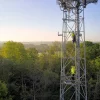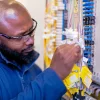Quickline Revise FTTP Broadband Build in York Village After Pole Complaints UPDATE

UK ISP Quickline, which is deploying a gigabit speed full fibre (FTTP) and fixed wireless (FWA) broadband network across rural parts of Yorkshire and Lincolnshire (England), has agreed to revise its roll-out plan for the North Yorkshire village of Skelton after residents and local politicians complained it would have a “huge visual impact” due to the use of 9m tall poles.
The provider is currently being backed by a private investment of £500m from Northleaf Capital Partners and aims to cover 200,000 premises with FTTP by the end of 2025 (up from 65,000 premises in Nov 2023). But as well as its own commercial builds, the operator also holds several state aid supported roll-out contracts for Yorkshire under the government’s £5bn Project Gigabit broadband programme.
The operator’s plan to expand their FTTP network into the village of Skelton, which is home to over 1,500 people, forms part of that Project Gigabit deployment. But not everybody in the community, which has not previously had any overhead telecoms infrastructure, was thrilled by Quickline’s original deployment plan – this included 46 brown wood telegraph poles on the pavements of 15 roads in Skelton (example application).
Advertisement
Broadband operators typically like poles because they’re very quick and cost-effective to build (several times cheaper than trenching), can be deployed in areas where there may be no space or access to safely put new underground cables, are less disruptive (avoiding the noise, access restrictions and damage to pavements of street works) and can be built under Permitted Development (PD) rights with only minimal prior notice.
The York Press reported that, after Quickline notified local residents of the work, around 150 people signed a petition against the proposal. Colin Ellis, clerk for Skelton Parish Council, said: “The parish council is really unanimous in that they’re not against improving technology infrastructure. But we are against the method of installation.” Local Labour MP, Luke Charters, similarly called the plan “ridiculous” and said the poles would have a “huge visual impact on the village“.
The new Labour-led government, much like the old Conservative-led one, recently responded to such concerns across the UK by calling on broadband operators to “end the deployment of unnecessary telegraph poles” (here), to “share existing infrastructure when installing broadband cables as the default approach” and pledged to “revise” the related Code of Practice. Both INCA and the ISPA have since published new ‘Best Practice Guidance’ for broadband operators that are building new poles, which requires greater community engagement (here).
The good news is that the new guidance (CoP) seems set to deliver a positive outcome, at least on this occasion.
Advertisement
A spokesperson for Quickline said:
“We’re committed to working closely with communities as we deliver improved broadband to rural areas like Skelton.
We first contacted the Parish Council in February to share our plans and invite discussion, followed by detailed maps and a letter drop to residents.
After listening to the feedback received from across the community, we reviewed our approach and explored the possibility of an underground solution.
We’ve since met with the local MP and look forward to attending the Parish Council meeting this week to talk through the revised plans.
Bringing faster, more reliable internet to rural communities is our priority and we want to do that in a way that works for everyone.”
One caveat above is that the statement doesn’t make completely clear whether Quickline will actually adopt an underground deployment for their revised plan or how extensive it will be, but such information should become clear after this week’s meeting. In any case, it appears as if the network operator is currently taking a positive pro-engagement approach to the issue, which would be in keeping with the new guidance.
The risk for Quickline is that going underground (trenching) is typically several times more expensive than using poles, which can in some cases push deployments – especially those in rural areas where digital infrastructure upgrades are already a very costly challenge – into becoming economically unviable or significantly reducing the operator’s potential network coverage.
We hope to update on this one shortly.
UPDATE 1:01pm
Advertisement
Quickline has informed ISPreview that their revised plan “includes no new poles“.
Mark is a professional technology writer, IT consultant and computer engineer from Dorset (England), he also founded ISPreview in 1999 and enjoys analysing the latest telecoms and broadband developments. Find me on X (Twitter), Mastodon, Facebook, BlueSky, Threads.net and Linkedin.
« Virgin Media O2 Business Launches Teams Phone Mobile





















































Finally an network operator listening to locals instead of alienating them by building regardless of concerns. Refreshing to see. It amazes me how some operators just alienate the potential customer base by just building infrastructure that they clearly don’t want.
Fully agree with your comments . It is indeed very refreshing to hear the residents the new pole infrastructure would have severely affected ,are being listened to . This should be an essential part of any build , unfortunately where there is not a solid community spirit that cares for the environment they live in ,there is not the pressure for these altnets to do the right thing to first share infrastructure or go underground . In fact adhere to their code of practise and not exploit government legislation permitted development
Kinda Stupid, vet these are the same sort of people to campaign against 5g poles, yet phone up to say they have no signal, or call up there ISP’s to say their “Wifi is slow”.
fttp is the future, 150 people with nothing else to worry about in life, 100% they going to moan more about the state of the roads and paths dug up.
They should be using OR poles and adding as very few as possibly, I get it. But still the need for full fibre is needed. If I lived there I’d be well annoyed.
I’ve had new poles near me, you notice it once or two, they blend in easily.
Love to post you a picture of duplicate and triplicate poles that blend in , but only if you were blind you might see. No one is against getting availability of FFTP just not by unnecessary infrastructure . Share infrastructure or go underground as the codes of practice clearly state
I don’t think you do “get it”. The article clearly states that there are NO poles, zero, rien, nothing. Adding poles in those circumstances is a big change and what’s more, the update says that Quickline can and will do it without poles. A little bit of community action and you preserve your environment. Finally you say some rather abusive things about these people. Evidence please or is it just a lazy assumption?
@Joyce the code of practice does not say share infrastructure or go underground. That is a blatant mistrust.
Pointless comment without any relevance to this post
Here in Burgh le Marsh most parts of the town can now order their service but my postcode in the town center has been left out while they continue to roll out to the most remote parts outside of the town.
In February they put up a notice to say there were going to build to a pole on my street but then last month the notice disappeared.
There was a work permit scheduled for June on the street but that’s now been cancelled.
Have called and emailed for an update but they never reply to emails and tell me when I call that they’ll get someone to call me back which they never do.
I don’t like to keep chasing them but not sure what else I can do to just get a simple answer.
I just want to get a better broadband connection than the copper fixed line service is awful
Would love to see the lovely parish come back and complain once they have massive civil works ripping up the highway to install new ducts/un-block existing ducts, or even having no place to put ducts therefore excluding some of the very same people who probably don’t have access to full fibre.
The fact that some people are so blind to the other way that fibre rollout happens, that they’ll complain about the civil works when they don’t want poles, but some how seem to think fibre can just magic itself into the ground in seconds and leave every inch of highway untouched.
Used to deal with people who were so full of themselves that they wanted “the pink footway” put back after works had gone through it and replaced it with new AC10.
Ah the public, don’t know the half of it when it comes to civils yet think that they are always right!!
This article state consultation happened and by the sound of it they are happier with underground installation. A win win all round. Operator for recognising potential customers and residents getting what they want. Nowhere in this article does it say that residents don’t want underground resolution so your comment hear seems to be mis-placed.
@steve the code of practise does state that at the design stage sharing infrastructure should be considered to preserve visual impact and ECC does say about preferably going underground . Yes none of this is mandatory , but it is best practise , something the telecommunications industry increasingly doesn’t adhere to since given permitted development . The telecommunications industry is increasingly unprofessional in its approach to providing services, legally I might add , shame governments will not curb your bad practices permanently